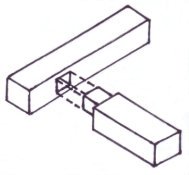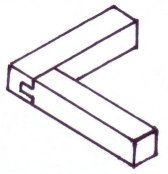The mortise and tenon joint is another one of the strongest and most appealing woodwork joints able to be made because of its flush fitting design.
Like the dovetail joint this woodwork joint can be difficult to properly construct but it is incredibly strong and aesthetically pleasing if constructed well.
This woodwork joint consist of a tongue that is secured into a slot and it is used in areas such as table legs. For structural areas like these the joint must be tight fitting to ensure maximum strength but also to achieve a neat flush look.
There are slightly different versions of this woodwork joint which include double tenons, twin tenons and haunched mortises and tenons.
The haunched version of this joint consist of an extra piece of wood that is half the depth of the mortise and it is mostly used at the end of the timber to prevent twisting.
The double and twin tenons are exactly as they sound being two tenons next to each other which create an even stronger joint. The double tenon is made of two separate tenons while the twin tenon is two tenons which are joined in the middle.
Areas where the mortise and tenon joint or some form of it are most effective and best suited are areas which are required to support a large amount of weight or are structurally important such as the rails and legs of a table or chair.
The tenons should be made to the correct length and thickness depending on how much weight will need to be supported.
For example if the joint is for a large dining table you will need a larger and thicker tenon or even a double or twin tenons to support the extra loads and weights the table will likely endure but also ensure the mortises are tight fitting to create the strongest and most aesthetically pleasing joint possible.



